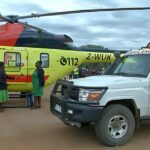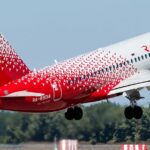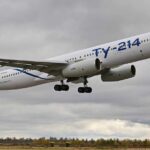The second Russia-Africa Economic Forum will be held in St Petersburg at the end of July. The events of the summit are aimed at comprehensive strengthening of Russian-African co-operation and are intended to determine the trajectory of Russia’s relations with African countries in the long term. The Forum’s programme of more than 30 panel sessions and thematic events will also include discussions on healthcare and logistics.
Russia, which has extensive experience in developing air ambulance services both in the densely populated central regions of the country and in hard-to-reach areas of Siberia and the Far North, assists in integrating high-tech medical assistance to African countries into their healthcare systems. Thus, in 2022, a number of contracts were signed for the supply of civil Mi-17 and Ansat helicopters for key federal structures of the Republic of Zimbabwe. In the spring of 2023, the first batch of 18 Ansats with medical modules arrived in this African country, and Zimbabwe thus became the first country in Africa to launch its own national air ambulance service. Sixty Russian-made helicopters will be delivered to the republic by 2025.
The availability of transcontinental and interregional transport infrastructure is of great importance for the development of market economies in African countries and the formation of subregional markets. However, African air transport has a very short history – only two companies in Egypt and Ethiopia are more than half a century old. All others were established at independence or later.
In the early 1960s, African states attempted to organise a Pan-African air network. To this end, several international alliances were created: the West African Air Corporation, the Central African Air Corporation, East African Airlines and the multinational Air Africa. However, all the alliances collapsed for political and economic reasons. The idea of the North African countries to create a united Air Maghreb airline was not realised either.
At the same time, in 2011, an SSJ100 aircraft of Moscovia Airlines performed passenger operations in Morocco on a wet lease basis for some time. The aircraft RA-89021 flew from Casablanca to Berlin-Tegel. At that time, Royal Air Maroc was selecting an aircraft to renew its fleet, and the Superjet participated in this selection, competing with the Embraer E190 and Bombardier CRJ100.
In 2018 in Gelendzhik, Russia and the Republic of Zambia signed a contract for the delivery of one SSJ100 aircraft in VIP version during the 2018 Hydroaviation Salon, the parties discussed the delivery of four more Superjets. But the agreement was not realised and the reasons for the breakdown of the deal were not reported.
Given that Russia has proclaimed and is actively demonstrating its return to the African continent, including in civil aviation, we asked Oleg Evdokimov, CEO of ATEO air, an expert on the aviation market of the Persian Gulf and the Middle East, for comments on this topic.
“Yes, you say everything right about the attempts to enter the African market with the Superjet. To what extent they were justified and timely at the time is a separate discussion, especially since the subsequent experience of operating the aircraft in Europe and Mexico, their maintenance and repair showed that Sukhoi Civil Aircraft and UAC were unprepared for the harsh reality of the European market,” says Oleg Evdokimov.
But now, according to him, the aircraft as a product is established, it flies a lot and performs a huge volume of transportations both domestically and abroad. UAC and Irkut ensure maintenance of its airworthiness. However, to offer SSJ100 or SSJ-New is, in the expert’s opinion, an unsolvable task due to the impossibility to provide spare parts and components for the aircraft in imported guise and unsolved issues of import substitution of the upgraded machine. At the same time, UAC has a product that could be offered to African countries.
“In June, I had a conversation with the president of a small country in the south-east of Africa. On his initiative, the country created an airline for passenger transport, and when it came to aircraft for it, the head of the country was surprised that he knew nothing about the Russian SSJ100 regional jet, which would be a good fit for the business model of the new airline. For the Russia-Africa Forum, this president will fly on a regular Ethiopian Airlines flight to Moscow and then on to St. Petersburg. It would be great to organise a return flight home for African leaders from St. Petersburg by Aurus VIP-Superjet at the end of the summit. It is clear that there are issues of safety of transporting a large number of heads of state at once, but if UAC wanted to, it could solve these issues,” the expert shares his opinion.
He noted that in conditions when MAKS has been cancelled and access to Farnborough and Le Bourget air shows is closed for Russia for many years, such a step would be an excellent advertisement for the Russian aircraft. “Showing the product with a face – what could be better to promote the Superjet to the friendly African market?” asks Oleg Evdokimov.
In addition, he says, there is an opportunity to resume negotiations on the purchase of SSJ100 aircraft stuck in Europe and, in particular, in Venice, as well as to try once again to resolve the fate of aircraft in Mexico, which belong to the bankrupt airline Interjet. “VEB and UAC risk losing not only the money lent by Interjet for the purchase of 22 Superjets, but also the aircraft themselves,” summarises Oleg Evdokimov.







